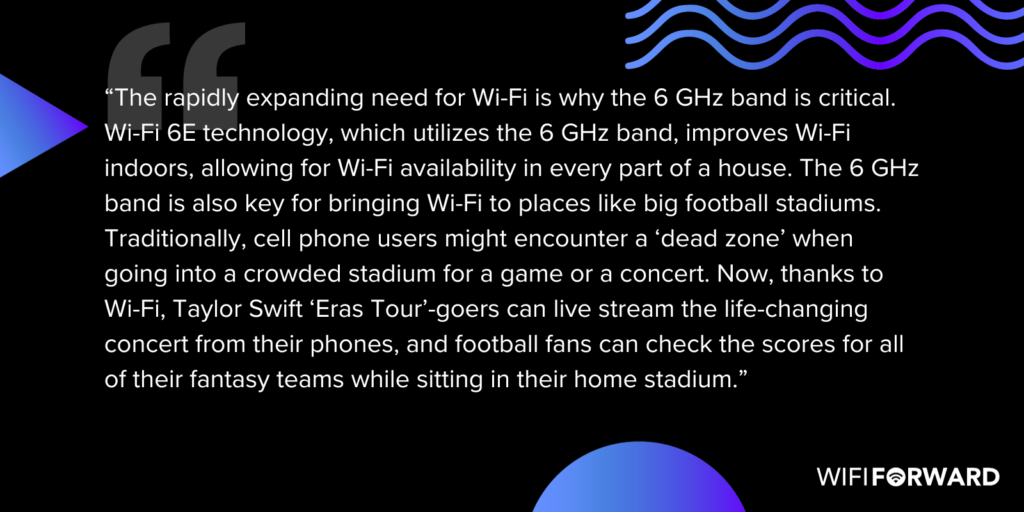The evolution of Wi-Fi is even more impressive than the average consumer might realize. Thirty years ago, when the FCC designated a handful of underused frequencies for unlicensed use, no one thought these “junk bands” would lead to anything. Instead, Wi-Fi – the premiere unlicensed technology and an American success story – is now ubiquitous. According to a recent study from the Wi-Fi Alliance, four in five households said their Wi-Fi use is expanding, and most expect Wi-Fi to be available in every room of their house. And beyond the home, users expect Wi-Fi everywhere from a plane, to their cars, and even big stadiums.
The rapidly expanding need for Wi-Fi is why the 6 GHz band is critical. Wi-Fi 6E technology, which utilizes the 6 GHz band, improves Wi-Fi indoors, allowing for Wi-Fi availability in every part of a house. The 6 GHz band is also key for bringing Wi-Fi to places like big indoor football stadiums. Traditionally, cell phone users might encounter a “dead zone” when going into a crowded stadium for a game or a concert. Now, thanks to Wi-Fi, Taylor Swift “Eras Tour”-goers can live stream the life-changing concert from their phones, and football fans can check the scores for all of their fantasy teams while sitting in their home stadium.
While Wi-Fi technology has made great strides in the 6 GHz band, certain FCC rules have placed burdensome restrictions on operators in this band. This doesn’t work in an industry that’s constantly innovating and bringing forth new, diverse technologies. Extreme Networks, a company that makes and operates Wi-Fi 6E technology, is one such example. In big indoor stadiums, Extreme Networks deploys their devices underneath seats, bringing connectivity to spectators who may otherwise run into cell service issues in such a crowded space. In many indoor stadiums, however, maintenance workers use power washers to clean underneath the seats, which can damage those Wi-Fi devices. There’s a commonsense solution – adding a weatherized case for the devices so they don’t get wet, even in an indoor stadium. So what’s the big deal?
Adding a weatherized case to a Wi-Fi device would violate the FCC’s rules for technology that operates in the 6 GHz band. Rules and regulations are important in unlicensed spectrum bands to ensure proper use and avoid interference. But in the 6 GHz band, these rules have restricted the use of new technology, and there are easy fixes to ensure that unlicensed technology can continue to thrive.
WifiForward supports Extreme Networks’ waiver request pending before the FCC to allow the use of weatherized cases on their indoor stadium Wi-Fi devices. Other supporters of Wi-Fi agree: “WiFi 6E/7 can provide an affordable and higher bandwidth alternative to the private 5G networks currently being marketed as the go-to wireless solution for sporting venues. But, next generation Wi-Fi can quickly lose its competitive potential if the equipment it requires is routinely disabled,” argued Public Knowledge and the Open Technology Institute in a filing to the FCC. According to the Wi-Fi Alliance, “failure to grant the requested waiver would deny Americans the benefits of expanded Wi-Fi capacity based on unrealistic assumptions.”
WifiForward urges the FCC to make use of its Knowledge Database (KDB) to address these issues in the future. Making every single company seek a waiver to improve their technology is a waste of valuable time as we rapidly innovate, but the FCC already has resources available to inform these decisions in the future.
There’s a huge “blank space” just waiting to be filled with new innovative technology, and burdensome FCC requirements are the “anti-hero” to unlicensed progress. Wi-Fi has been such a success because innovation was allowed to thrive on its own in the original junk bands – let’s “shake it off” with those old rules so that technology – and Swifties – can continue to thrive.

